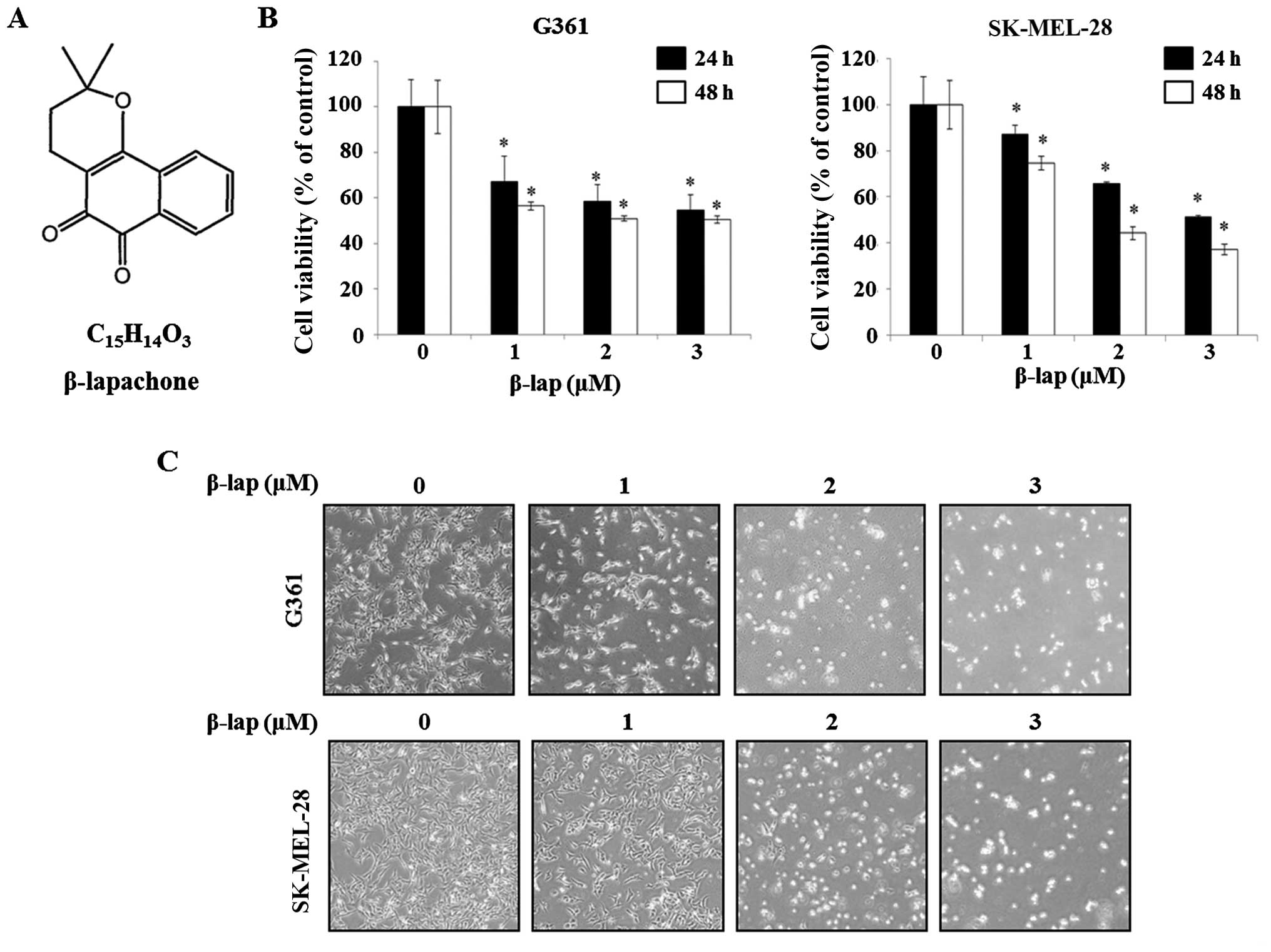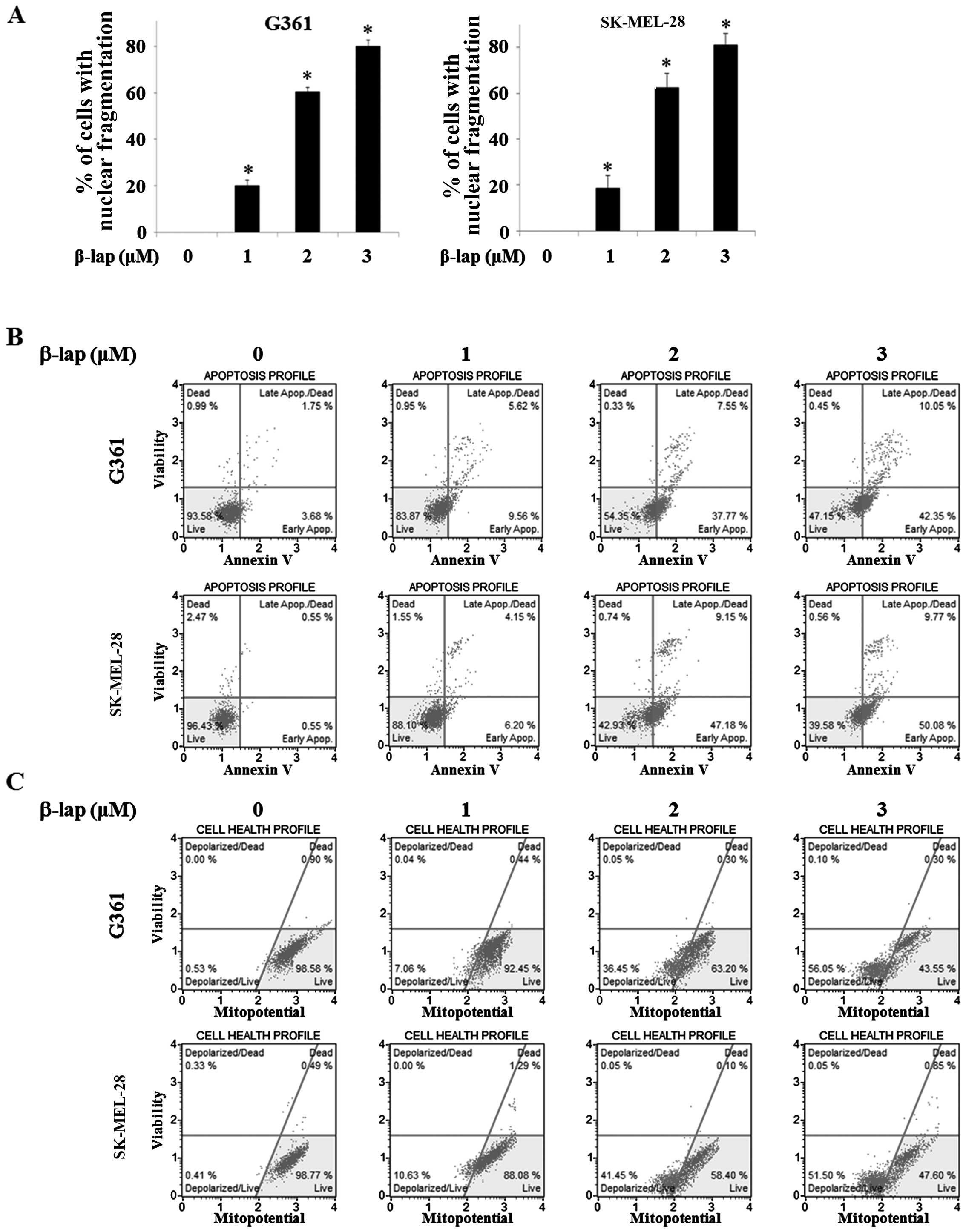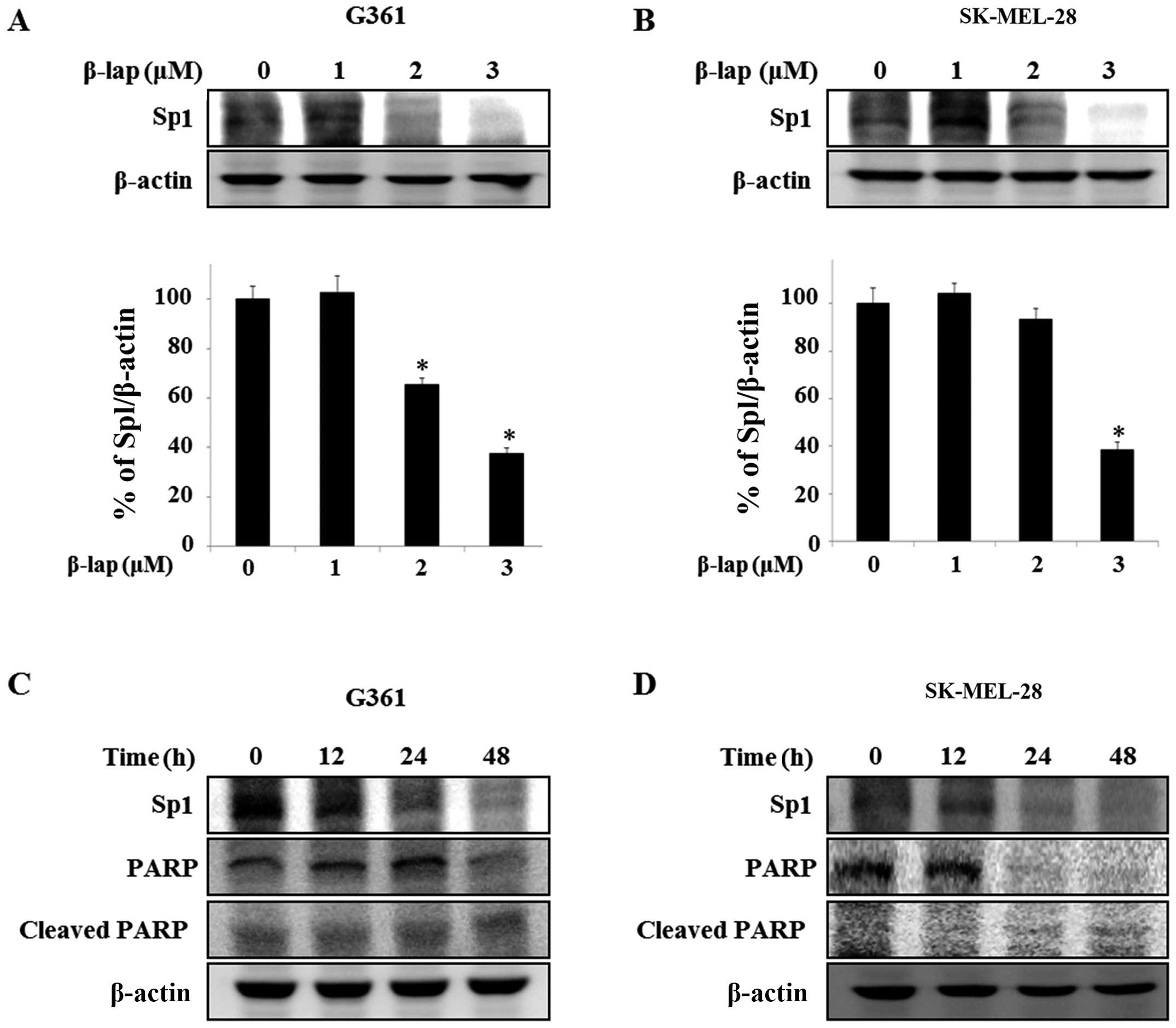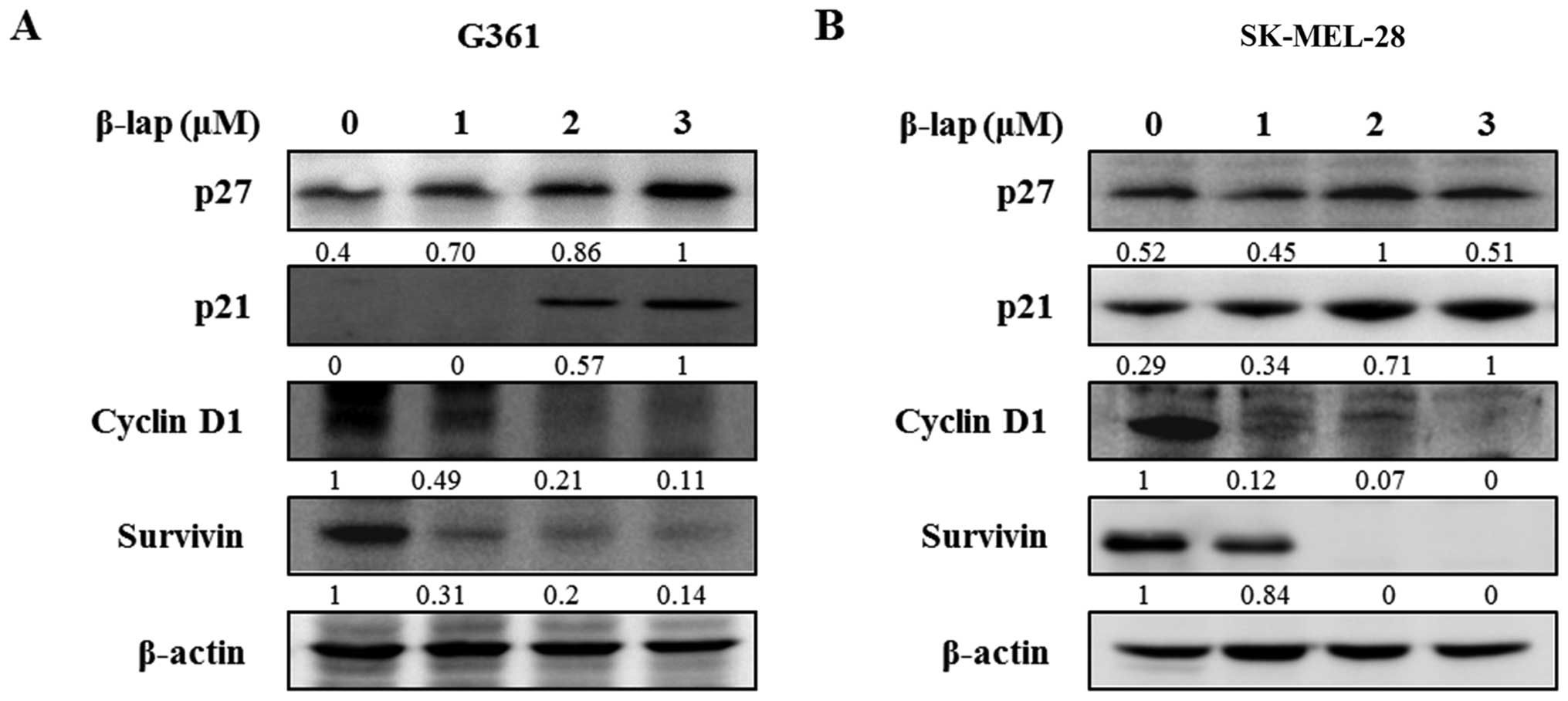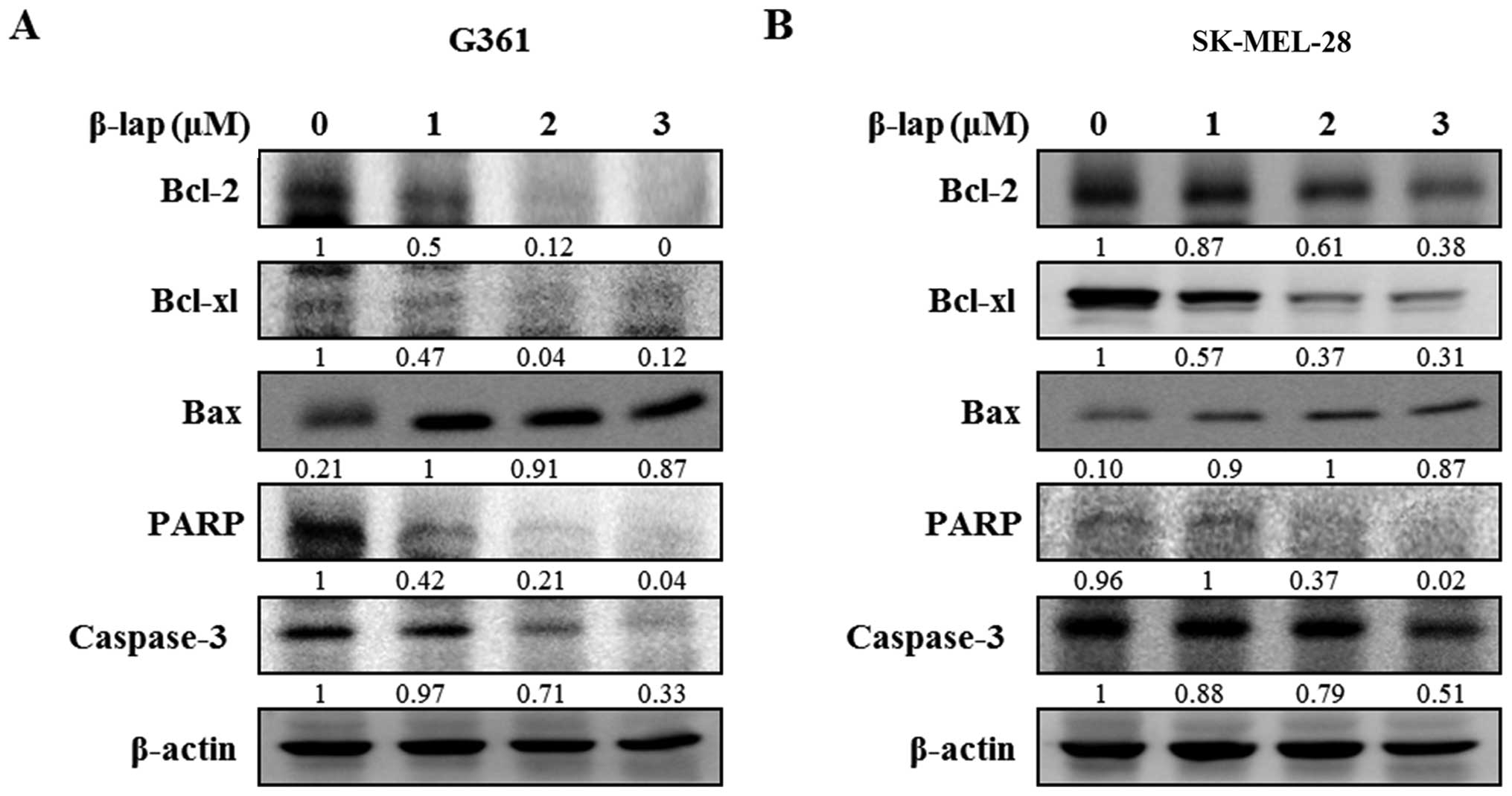β-lapachone suppresses the proliferation of human malignant melanoma cells by targeting specificity protein 1
- Authors:
- Published online on: November 20, 2015 https://doi.org/10.3892/or.2015.4439
- Pages: 1109-1116
Abstract
Introduction
Human malignant melanoma (HMM), the most deadly form of skin cancer, is found in the outer layer of the skin and is responsible for ~60% of lethal skin tumors (1). HMM incidence and mortality have steadily increased over the last 50 years in the fair-skinned population (2). The most common risk factors for the development of HMM include exposure to ultraviolet radiation (especially in childhood), fair skin, dysplastic nevi syndrome, age and family history (3). Current treatment modalities for HMM, including surgery, radiation and chemotherapy, are not efficient enough to prevent the spread of metastases in up to 50% of patients (4). For patients with stage IV disease, the melanoma has spread beyond the local area into other parts of the body or internal organs. Although surgery and radiation therapy are the main treatment for malignant melanoma, systemic therapy such as cytotoxic chemotherapy and immunotherapy is the mainstay of treatment for most patients with stage IV melanoma (5). Therefore, there is an ongoing quest for novel effective chemotherapeutic agents for HMM. One of the recently suggested agents for the treatment of cancer is β-lapachone (β-lap).
β-lap (3.4-dihydro-2,2-dimethyl-2H-naphthol[1,2-b]pyran-5,6-dione) is a natural quinone derived from the bark of the Pink trumpet tree (Tabebuia avellanedae), which has been used in traditional medicine for centuries (6). Previous studies have reported that β-lap has anti-bacterial (7), anti-fungal (7), anti-inflammatory (8), anti-viral (9), anti-proliferative (10,11), anti-psoriasis (12), and anti-arthritic properties (13). In addition, β-lap was also reported to sensitize cancer cells to ionizing radiation (14), DNA damaging agents (15) and increase the generation of reactive oxygen species (16). In particular, the anti-proliferative effect of β-lap on various cancer cell lines including prostate cancer (10,11,17), breast cancer (18,19), lung cancer (20) and gastric carcinoma (21) has been reported.
Specificity protein 1, a member of the specificity protein/Kruppel-like factor family of transcription factors, is responsible for a variety of cellular processes (22). Previous studies have reported that Sp1 is related to tumorigenesis by modulating transcription associated with cell growth and proliferation (23). Furthermore, Sp1 is highly expressed in various cancer cell lines compared to normal cells. In this regard, a decrease in cancer proliferation was found to occur following inhibition of Sp1 by small interfering RNA in nude mice (15,24–26). Hence, many studies have revealed that regulation of the function by Sp1 is a promising therapeutic target in cancer (27).
Although the anti-proliferative properties of β-lap against several cancer cell lines have been demonstrated, its effect on HMM and the mechanisms of β-lap-induced apoptosis are not yet fully understood. In this study, we examined the effect of β-lap on two HMM cell lines, G361 and SK-MEL-28. We determined that β-lap inhibited cell viability and induced apoptosis in the G361 and SK-MEL-28 cells. The results from the present study provide experimental evidence to support the hypothesis that β-lap decreases Sp1 expression and inhibits HMM cell viability by inducing cell cycle arrest and apoptosis. Our results reinforce the potential pharmacological interest of β-lap, as confirmed by the suppression of Sp1 in HMM cells.
Materials and methods
Cell culture
Human malignant melanoma (HMM) cell lines, G361 and SK-MEL-28, were cultured in Hyclone Dulbecco's modified Eagle's medium (DMEM; Welgene, Dea-gu, Korea) with 10% fetal bovine serum (FBS) and 100 U/ml each of penicillin and streptomycin (Gibco, Grand Island, NY, USA) at 37°C with 5% CO2 in a humidified atmosphere.
Cell viability assay
Viability of the G361 and SK-MEL-28 cells treated with β-lap was measured using the CellTiter96® Aqueous One cell proliferation assay kit (Promega, Madison, WI, USA) according to the manufacturer's instructions. The effect of β-lap on the viability of the G361 and SK-MEL-28 cells was estimated by 3-(4,5-dimethylthiazol-2-yl)-5-(3-carb-oxymethoxyphenyl)-2-(4-sulfophenyl)-2H-tetrazolium (MTS) assay. G361 (3×103) and SK-MEL-28 (3×103) cells were seeded into 96-well plates and were treated with various concentrations of β-lap for 24 and 48 h. MTS reagent was added directly to the cells and incubated at 37°C. Absorbance was measured using an absorbance microplate reader (Biotek, Winooski, VT, USA) at 490 nm. All experiments were carried out in triplicates, and the percentage of cell viability of the β-lap-treated cells was normalized to that of the untreated control cells.
DAPI staining
Chromatin condensation and nuclear fragmentation in apoptotic cells were assessed by 4′,6-diamidino-2-phenylindole (DAPI) staining. G361 and SK-MEL-28 cells were treated with various concentrations of β-lap for 48 h and then harvested by trypsinization. The detached cells were fixed in 100% methanol at room temperature for 30 min, deposited on slides, and stained with DAPI (Sigma-Aldrich, St. Louis, MO, USA) solution (2 µg/ml). Cell morphology was observed under a FluoView confocal laser microscope (Fluoview FV10i; Olympus Corporation, Tokyo, Japan).
Annexin V and Dead Cell assay
Annexin V and Dead Cell assay was performed using Muse™ Cell Analyzer from Millipore (Billerica, MA, USA) following the manufacturer's instructions. Briefly, after treatment with the various concentrations of β-lap, the G361 and SK-MEL-28 cells were incubated with Annexin V and Dead cell reagent (7-ADD) and the events for dead, late apoptotic, early apoptotic, and live cells were counted.
Mitochondrial membrane potential (MMP) assay
MMP was determined with 5,5′,6,6′-tetrachloro-1,1′,3,3′-tetraethyl-benz-imidazolyl-carbocyanine iodine (JC-1) by using the Muse™ Cell Analyzer from Millipore following the manufacturer's instructions. The samples were analyzed by flow cytometry and counted (10,000 cells/sample). Loss of MMP was quantified as the percentage of cells expressing JC-1 monomer fluorescence.
Western blot analysis
G361 and SK-MEL-28 cells were treated with β-lap, and then the cells were washed twice with ice-cold PBS. Whole cell lysate was prepared using M-PER® Mammalian Protein Extraction reagent (Thermo Scientific, Rockford, IL, USA) containing a protease inhibitor cocktail (Roche, Switzerland). Protein concentrations were estimated using the BCA protein assay kit (Thermo Scientific). The samples were separated by 8 or 12% SDS-polyacrylamide gel electrophoresis, and were then transferred to polyvinylidene difluoride (PVDF) membranes (Millipore). The membranes were blocked with 5% (v/v) skim milk in TBS buffer containing 0.1% Tween-20 and then incubated with the primary antibody overnight at 4°C. Subsequently, the membranes were washed 5 times in TBS buffer including 0.1% Tween-20 for 10 min and incubated with horseradish peroxidase-conjugated anti-mouse, anti-rabbit or anti-goat IgG antibodies. The membranes were visualized using a chemiluminescent ECL detection kit (Thermo Scientific) and detected using ImageQuant Las 4000 Mini (GE Healthcare Life Sciences) according to the manufacturer's instructions.
Statistical analysis
Data are reported as the means ± SD of triplicate independent experiment. Statistical significance was assessed using the Student's t-test. A value of P<0.05 compared with the untreated control was considered to be statistically significant.
Results
β-lap inhibits the cell viability of HMM cells
Previous studies have reported that β-lap has anti-proliferative effects on several different cancer cells (10,11). The structure of β-lap is shown in Fig. 1A. To investigate the effect of β-lap on G361 and SK-MEL-28 cells, cell viability was measured using MTS assay. The cell viability of G361 was 56.5±0.02, 50.9±0.01 and 50.5±0.01 following treatment with 1, 2 and 3 µM of β-lap, respectively, compared with the untreated control cells at 48 h post-treatment. In the case of SK-MEL-28 cells, cell viability was 74.5±0.03, 44.1±0.03 and 37.0±0.02 following treatment with 1, 2 and 3 µM of β-lap for 48 h, respectively, compared to that of the untreated control cells at 48 h post-treatment. The results indicated that β-lap decreased the viability of G361 and SK-MEL-28 cells in a dose- and time-dependent manner (Fig. 1B). Following, the morphological alterations of the G361 and SK-MEL-28 cells were observed using an optical microscope following treatment with β-lap (1-3 µM) for 48 h. As shown Fig. 1C, the numbers of irregular and rounded cells were increased by β-lap (0, 1, 2 and 3 µM). Thus, these results determined that β-lap inhibited the cell viability of the HMM cells.
β-lap induces apoptosis in HMM cells
In order to investigate apoptotic morphological alterations in the G361 and SK-MEL-28 cells, they were treated with β-lap at various concentrations (0, 1, 2 and 3 µM). The cells were stained with DAPI and then observed under a FluoView confocal laser microscope. As shown in Fig. 2A, the percentage of cells with nuclear condensation and perinuclear apoptotic bodies was increased in a β-lap dose-dependent manner in the HMM cells.
We confirmed that apoptosis was mainly induced upon exposure to β-lap by the Annexin V and Dead Cell assay and MMP assay in the G361 and SK-MEL-28 cells. The upper right quadrant and the lower right quadrant, respectively, indicated late and early apoptotic cells and the percentage of these apoptotic cells was increased by β-lap (1, 2 and 3 µM) when compared to the cells without treatment (Fig. 2B). The lower left quadrant indicated depolarized cells and the percentage of these cells was increased by β-lap (0, 1, 2 and 3 µM) (Fig. 2C). These results indicated that β-lap treatment effectively inhibited cell proliferation, leading to apoptosis in the HMM cells.
Expression of Sp1 is suppressed by β-lap in HMM cells
Sp1 is overexpressed in various human cancers, including human glioblastoma (28), lung cancer (24) and pancreatic cancer (29), and is regulated by chemotherapeutic agents (30) and natural compounds, including honokiol and esculetin (27,31). Thus, we investigated whether the expression level of Sp1 was regulated by β-lap in the HMM G361 and SK-MEL-28 cells. We determined whether the expression level of Sp1 was altered by β-lap in the G361 and SK-MEL-28 cells. We detected Sp1 expression levels by western blot analysis. The expression levels were significantly reduced in the treated cells, with a maximum decrease of 62.4±0.01% in the G361 cells compared to the untreated cells and a maximum decrease of 61.6±0.01% was noted in the SK-MEL-28 cells compared to the untreated group (Fig. 3A and B). To further determine the apoptotic effect by the downregulation of Sp1 in the cells treated with β-lap, we treated the G361 and SK-MEL-28 cells with 3 µM β-lap for different times (0, 12, 24 and 48 h) and investigated the expression levels of PARP and cleaved PARP (Fig. 3C and D). Thus, these results demonstrated that β-lap induces apoptosis through downregulation of Sp1.
β-lap regulates cell cycle arrest and apoptosis in the HMM cells
To investigate the regulatory effect of β-lap, we examined the changes in expression levels of Sp1 downstream targets and apoptosis-related proteins. The cell cycle arrest proteins, including p27 and p21, were significantly increased following treatment with different concentrations of β-lap, whereas cell proliferation and survival-related proteins, cyclin D1 and survivin, were decreased by β-lap in a concentration-dependent manner (Fig. 4). In addition, we assessed the expression levels of several pro- and anti-apoptotic proteins in the β-lap-treated G361 and SK-MEL-28 cells. As shown in Fig. 5, β-lap reduced the expression of Bcl-2 and Bcl-xl, and increased the expression of Bax to induce apoptotic cell death. β-lap also concentration-dependently caused activation of caspase-3 and PARP in the HMM cells. Our results showed that β-lap induced the downregulation of Sp1, resulting in cell cycle arrest and induction of apoptosis in the HMM cells.
Discussion
HMM is one of the most deadly types of skin cancer and its incidence has increased over the last 50 years in the fair-skinned population (2). Surgery, thermotherapy, chemotherapy and radiotherapy are used to treat HMM although these methods cause side effects, such as cytotoxicity to normal cells and host immune reaction (32). Hence, the objective of studies has concentrated upon natural compounds derived or originating from Mother Nature (33). Moreover, the value of natural compounds with anti-proliferative properties has been considered to play an important role in cancer therapy. In the present study, we concentrated on the anti-proliferative effect of β-lap, a novel natural quinone derived from the bark of the Pink trumpet tree (Tabebuia avellanedae) (34). β-lap has been reported as being a topoisomerase I and II inhibitor (35,36), and was found to inhibit lymphocyte-(37), neutrophil-(37) and macrophage-related joint inflammatory (37). Thus, β-lap may be a potential agent against anti-proliferation. In this regard, several studies have reported that β-lap has an anti-proliferation effect on various cancer-derived cells, including breast carcinoma (18,19) prostate carcinoma (10,11,17), lung carcinoma (20) and gastric carcinoma (21). Despite numerous studies on cancer cells, the anti-proliferative properties of β-lap on HMM cells are not well understood.
In the present study, we demonstrated that β-lap induced apoptosis in HMM G361 and SK-MEL-28 cells. The apoptosis was accompanied by morphological alterations, such as chromatin condensation and rounded cells. We observed an increase in nuclear condensation and perinuclear apoptotic bodies though DAPI staining, and determined changes in the percentages of apoptotic and depolarized cells by Annexin V and Dead Cell assay and MMP assay following β-lap treatment. These results suggest that β-lap induces apoptosis in HMM cells.
The transcription factor, Sp1, is responsible for a variety of cellular processes, including transcription initiation, survival, cell growth, differentiation, metabolism and angiogenesis (38,39). Previous studies have reported that Sp1 is overexpressed in cancer cells and contributes to the formation of cancer (40) as well as regulates cell cycle- and apoptosis-associated proteins (25,41,42). In addition, several studies have shown that inhibition of Sp1 plays a role in growth inhibition and induction of apoptosis in malignant pleural mesothelioma and that Sp1 is activated in melanoma cells (43,44). For these reasons, the regulation of Sp1 has been suggested to enhance the efficacy of cancer therapy and improve poor prognosis. Our data showed that the expression level of Sp1 was significantly deceased in the β-lap-treated HMM cells.
p21 and p27 are well known as negative regulators of cell cycle progression (45). The functions of p21 and p27 are responsible for sub-G1 phase arrest by interaction between cyclins and cyclin-dependent kinase (CDK) complexes (46,47). Cyclin D1 performs functions, including proto-oncogene (48), tumorigenesis (49), cell maintenance (49) and integrator of extracellular signals of cells in early to mid-G1 phase (50). Survivin, an inhibitor of apoptosis (IAP) (51), plays an important role in mitosis and cell cycle arrest and apoptosis (52) and is also associated with Sp1-related oncogenes (53). The apoptotic caspases appear to be activated in a protease cascade and activated apical caspases respond to apoptotic stimuli and directly activate the effector caspases in a precisely controlled process (54). Among these caspases, caspase-3 plays a central role in the execution phase of both the intrinsic and extrinsic pathways of apoptosis by cleaving key cellular proteins, such as PARP (55). These cleavages regulate disassembly of the cell into the typical apoptotic morphological alterations, including cell shrinkage, chromatin condensation and DNA fragmentation (56). PARP is activated by binding DNA strand breaks produced by various DNA damaging agents, including hydrogen peroxide (57). Bcl-2 and Bcl-xl, blockers of cell death, are anti-apoptotic proteins and Bax, which promotes cell death, is a pro-apoptotic protein (58,59). The results showed that β-lap-induced apoptosis was accompanied by the upregulation of p27, p21 and Bax and downregulation of cyclin D1, survivin, Bcl2, Bcl-xl, PARP and caspase-3, strongly suggesting that β-lap is a potential apoptosis-inducing agent by regulating Sp1 protein to exert anti-proliferation activity in HMM cells.
In the present study, we investigated the anti-proliferative effect of β-lap on HMM cells. The results of our study showed that β-lap inhibited cell growth and induced apoptosis through regulation of anti- and pro-apoptotic proteins by Sp1. Therefore, these results suggest that the anti-proliferative and apoptotic effects of β-lap are modulated by the regulation of Sp1-mediated gene products.
Acknowledgments
This study was supported by the Next-Generation BioGreen 21 Program (PJ01116401), Rural Development Administration, Republic of Korea.
References
|
Bandarchi B, Ma L, Navab R, Seth A and Rasty G: From melanocyte to metastatic malignant melanoma. Dermatol Res Pract. 2010:5837482010.PubMed/NCBI | |
|
Ferlay J, Steliarova-Foucher E, Lortet-Tieulent J, Rosso S, Coebergh JW, Comber H, Forman D and Bray F: Cancer incidence and mortality patterns in Europe: Estimates for 40 countries in 2012. Eur J Cancer. 49:1374–1403. 2013. View Article : Google Scholar : PubMed/NCBI | |
|
Erdmann F, Lortet-Tieulent J, Schüz J, Zeeb H, Greinert R, Breitbart EW and Bray F: International trends in the incidence of malignant melanoma 1953–2008 - are recent generations at higher or lower risk? Int J Cancer. 132:385–400. 2013. View Article : Google Scholar | |
|
Kesmodel SB and Spitz FR: Gene therapy for cancer and metastatic disease. Expert Rev Mol Med. 5:1–18. 2003. View Article : Google Scholar : PubMed/NCBI | |
|
Bhatia S, Tykodi SS and Thompson JA: Treatment of metastatic melanoma: An overview. Oncology (Williston Park). 23:488–496. 2009. | |
|
Moon DO, Kang CH, Kim MO, Jeon YJ, Lee JD, Choi YH and Kim GY: Beta-lapachone (LAPA) decreases cell viability and telomerase activity in leukemia cells: Suppression of telomerase activity by LAPA. J Med Food. 13:481–488. 2010. View Article : Google Scholar : PubMed/NCBI | |
|
Guiraud P, Steiman R, Campos-Takaki GM, Seigle-Murandi F and Simeon de Buochberg M: Comparison of antibacterial and antifungal activities of lapachol and beta-lapachone. Planta Med. 60:373–374. 1994. View Article : Google Scholar : PubMed/NCBI | |
|
de Almeida ER, da Silva Filho AA, dos Santos ER and Lopes CA: Antiinflammatory action of lapachol. J Ethnopharmacol. 29:239–241. 1990. View Article : Google Scholar : PubMed/NCBI | |
|
Li CJ, Zhang LJ, Dezube BJ, Crumpacker CS and Pardee AB: Three inhibitors of type 1 human immunodeficiency virus long terminal repeat-directed gene expression and virus replication. Proc Natl Acad Sci USA. 90:1839–1842. 1993. View Article : Google Scholar : PubMed/NCBI | |
|
Planchon SM, Wuerzberger S, Frydman B, Witiak DT, Hutson P, Church DR, Wilding G and Boothman DA: Beta-lapachone-mediated apoptosis in human promyelocytic leukemia (HL-60) and human prostate cancer cells: A p53-independent response. Cancer Res. 55:3706–3711. 1995.PubMed/NCBI | |
|
Planchon SM, Pink JJ, Tagliarino C, Bornmann WG, Varnes ME and Boothman DA: Beta-lapachone-induced apoptosis in human prostate cancer cells: Involvement of NQO1/xip3. Exp Cell Res. 267:95–106. 2001. View Article : Google Scholar : PubMed/NCBI | |
|
Müller K, Sellmer A and Wiegrebe W: Potential antipsoriatic agents: Lapacho compounds as potent inhibitors of HaCaT cell growth. J Nat Prod. 62:1134–1136. 1999. View Article : Google Scholar : PubMed/NCBI | |
|
Sitônio MM, Carvalho Júnior CH, Campos IA, Silva JB, Lima MC, Góes AJ, Maia MB, Rolim Neto PJ and Silva TG: Anti-inflammatory and anti-arthritic activities of 3,4-dihydro-2,2-dimethyl-2H-naphthol[1,2-b]pyran-5,6-dione (β-lapachone). Inflamm Res. 62:107–113. 2013. View Article : Google Scholar | |
|
Frydman B, Marton LJ, Sun JS, Neder K, Witiak DT, Liu AA, Wang HM, Mao Y, Wu HY, Sanders MM, et al: Induction of DNA topoisomerase II-mediated DNA cleavage by beta-lapachone and related naphthoquinones. Cancer Res. 57:620–627. 1997.PubMed/NCBI | |
|
Chau YP, Shiah SG, Don MJ and Kuo ML: Involvement of hydrogen peroxide in topoisomerase inhibitor beta-lapachone-induced apoptosis and differentiation in human leukemia cells. Free Radic Biol Med. 24:660–670. 1998. View Article : Google Scholar : PubMed/NCBI | |
|
Shiah SG, Chuang SE, Chau YP, Shen SC and Kuo ML: Activation of c-Jun NH2-terminal kinase and subsequent CPP32/Yama during topoisomerase inhibitor beta-lapachone-induced apoptosis through an oxidation-dependent pathway. Cancer Res. 59:391–398. 1999.PubMed/NCBI | |
|
Choi YH, Kang HS and Yoo MA: Suppression of human prostate cancer cell growth by beta-lapachone via down-regulation of pRB phosphorylation and induction of Cdk inhibitor p21(WAF1/CIP1). J Biochem Mol Biol. 36:223–229. 2003. View Article : Google Scholar : PubMed/NCBI | |
|
Pink JJ, Wuerzberger-Davis S, Tagliarino C, Planchon SM, Yang X, Froelich CJ and Boothman DA: Activation of a cysteine protease in MCF-7 and T47D breast cancer cells during beta-lapachone-mediated apoptosis. Exp Cell Res. 255:144–155. 2000. View Article : Google Scholar : PubMed/NCBI | |
|
Wuerzberger SM, Pink JJ, Planchon SM, Byers KL, Bornmann WG and Boothman DA: Induction of apoptosis in MCF-7:WS8 breast cancer cells by beta-lapachone. Cancer Res. 58:1876–1885. 1998.PubMed/NCBI | |
|
Dong GZ, Oh ET, Lee H, Park MT, Song CW and Park HJ: Beta-lapachone suppresses radiation-induced activation of nuclear factor-kappaB. Exp Mol Med. 42:327–334. 2010. View Article : Google Scholar : PubMed/NCBI | |
|
Yu HY, Kim SO, Jin CY, Kim GY, Kim WJ, Yoo YH and Choi YH: β-lapachone-induced apoptosis of human gastric carcinoma AGS cells is caspase-dependent and regulated by the PI3K/Akt pathway. Biomol Ther (Seoul). 22:184–192. 2014. View Article : Google Scholar | |
|
Wierstra I: Sp1: Emerging roles - beyond constitutive activation of TATA-less housekeeping genes. Biochem Biophys Res Commun. 372:1–13. 2008. View Article : Google Scholar : PubMed/NCBI | |
|
Black AR, Black JD and Azizkhan-Clifford J: Sp1 and krüppel-like factor family of transcription factors in cell growth regulation and cancer. J Cell Physiol. 188:143–160. 2001. View Article : Google Scholar : PubMed/NCBI | |
|
Kong LM, Liao CG, Fei F, Guo X, Xing JL and Chen ZN: Transcription factor Sp1 regulates expression of cancer-associated molecule CD147 in human lung cancer. Cancer Sci. 101:1463–1470. 2010. View Article : Google Scholar : PubMed/NCBI | |
|
Sankpal UT, Goodison S, Abdelrahim M and Basha R: Targeting Sp1 transcription factors in prostate cancer therapy. Med Chem. 7:518–525. 2011. View Article : Google Scholar : PubMed/NCBI | |
|
Jiang Y, Wang L, Gong W, Wei D, Le X, Yao J, Ajani J, Abbruzzese JL, Huang S and Xie K: A high expression level of insulin-like growth factor I receptor is associated with increased expression of transcription factor Sp1 and regional lymph node metastasis of human gastric cancer. Clin Exp Metastasis. 21:755–764. 2004. View Article : Google Scholar | |
|
Kim DW, Ko SM, Jeon YJ, Noh YW, Choi NJ, Cho SD, Moon HS, Cho YS, Shin JC, Park SM, et al: Anti-proliferative effect of honokiol in oral squamous cancer through the regulation of specificity protein 1. Int J Oncol. 43:1103–1110. 2013.PubMed/NCBI | |
|
Zhang R, Luo H, Wang S, Chen W, Chen Z, Wang HW, Chen Y, Yang J, Zhang X, Wu W, et al: MicroRNA-377 inhibited proliferation and invasion of human glioblastoma cells by directly targeting specificity protein 1. Neuro Oncol. 16:1510–1522. 2014. View Article : Google Scholar : PubMed/NCBI | |
|
Abdelrahim M, Smith R III, Burghardt R and Safe S: Role of Sp proteins in regulation of vascular endothelial growth factor expression and proliferation of pancreatic cancer cells. Cancer Res. 64:6740–6749. 2004. View Article : Google Scholar : PubMed/NCBI | |
|
Shin JA, Han G, Kim HJ, Kim HM and Cho SD: Chemopreventive and chemotherapeutic effect of a novel histone deacetylase inhibitor, by specificity protein 1 in MDA-MB-231 human breast cancer cells. Eur J Cancer Prev. 23:277–285. 2014. View Article : Google Scholar : PubMed/NCBI | |
|
Cho JH, Shin JC, Cho JJ, Choi YH, Shim JH and Chae JI: Esculetin (6,7-dihydroxycoumarin): A potential cancer chemo-preventive agent through suppression of Sp1 in oral squamous cancer cells. Int J Oncol. 46:265–271. 2015. | |
|
Safdie FM, Dorff T, Quinn D, Fontana L, Wei M, Lee C, Cohen P and Longo VD: Fasting and cancer treatment in humans: A case series report. Aging (Albany NY). 1:988–1007. 2009. | |
|
Wilson RM and Danishefsky SJ: Small molecule natural products in the discovery of therapeutic agents: The synthesis connection. J Org Chem. 71:8329–8351. 2006. View Article : Google Scholar : PubMed/NCBI | |
|
Tobin DD, Menon M, Menon M, Spatta BC, Hodges EV and Perry DG: The intrapsychics of gender: A model of self-socialization. Psychol Rev. 117:601–622. 2010. View Article : Google Scholar : PubMed/NCBI | |
|
Li CJ, Averboukh L and Pardee AB: Beta-lapachone, a novel DNA topoisomerase I inhibitor with a mode of action different from camptothecin. J Biol Chem. 268:22463–22468. 1993.PubMed/NCBI | |
|
Jackson JK, Higo T, Hunter WL and Burt HM: Topoisomerase inhibitors as anti-arthritic agents. Inflamm Res. 57:126–134. 2008. View Article : Google Scholar : PubMed/NCBI | |
|
Tudan C, Jackson JK, Higo TT and Burt HM: The effect of inhibiting topoisomerase I and II on the anti-apoptotic response associated with pro-inflammatory crystals of calcium pyrophosphate dihydrate in human neutrophils. Inflamm Res. 52:8–17. 2003. View Article : Google Scholar : PubMed/NCBI | |
|
Safe S and Abdelrahim M: Sp transcription factor family and its role in cancer. Eur J Cancer. 41:2438–2448. 2005. View Article : Google Scholar : PubMed/NCBI | |
|
Li L and Davie JR: The role of Sp1 and Sp3 in normal and cancer cell biology. Ann Anat. 192:275–283. 2010. View Article : Google Scholar : PubMed/NCBI | |
|
Hsu TI, Wang MC, Chen SY, Yeh YM, Su WC, Chang WC and Hung JJ: Sp1 expression regulates lung tumor progression. Oncogene. 31:3973–3988. 2012. View Article : Google Scholar : | |
|
Kavurma MM and Khachigian LM: Sp1 inhibits proliferation and induces apoptosis in vascular smooth muscle cells by repressing p21WAF1/Cip1 transcription and cyclin D1-Cdk4-p21WAF1/Cip1 complex formation. J Biol Chem. 278:32537–32543. 2003. View Article : Google Scholar : PubMed/NCBI | |
|
Xu R, Zhang P, Huang J, Ge S, Lu J and Qian G: Sp1 and Sp3 regulate basal transcription of the survivin gene. Biochem Biophys Res Commun. 356:286–292. 2007. View Article : Google Scholar : PubMed/NCBI | |
|
Chae JI, Jeon YJ and Shim JH: Downregulation of Sp1 is involved in honokiol-induced cell cycle arrest and apoptosis in human malignant pleural mesothelioma cells. Oncol Rep. 29:2318–2324. 2013.PubMed/NCBI | |
|
Hong IK, Byun HJ, Lee J, Jin YJ, Wang SJ, Jeoung DI, Kim YM and Lee H: The tetraspanin CD81 protein increases melanoma cell motility by up-regulating metalloproteinase MT1-MMP expression through the pro-oncogenic Akt-dependent Sp1 activation signaling pathways. J Biol Chem. 289:15691–15704. 2014. View Article : Google Scholar : PubMed/NCBI | |
|
Liu X, Yang WT and Zheng PS: Msi1 promotes tumor growth and cell proliferation by targeting cell cycle checkpoint proteins p21, p27 and p53 in cervical carcinomas. Oncotarget. 5:10870–10885. 2014. View Article : Google Scholar : PubMed/NCBI | |
|
Sherr CJ and Roberts JM: CDK inhibitors: Positive and negative regulators of G1-phase progression. Genes Dev. 13:1501–1512. 1999. View Article : Google Scholar : PubMed/NCBI | |
|
Murray AW: Recycling the cell cycle: Cyclins revisited. Cell. 116:221–234. 2004. View Article : Google Scholar : PubMed/NCBI | |
|
Ewen ME and Lamb J: The activities of cyclin D1 that drive tumorigenesis. Trends Mol Med. 10:158–162. 2004. View Article : Google Scholar : PubMed/NCBI | |
|
Weinstein IB: Relevance of cyclin D1 and other molecular markers to cancer chemoprevention. J Cell Biochem Suppl. 25:23–28. 1996. View Article : Google Scholar : PubMed/NCBI | |
|
Fu M, Wang C, Li Z, Sakamaki T and Pestell RG: Minireview: Cyclin D1: normal and abnormal functions. Endocrinology. 145:5439–5447. 2004. View Article : Google Scholar : PubMed/NCBI | |
|
Li F, Ambrosini G, Chu EY, Plescia J, Tognin S, Marchisio PC and Altieri DC: Control of apoptosis and mitotic spindle checkpoint by survivin. Nature. 396:580–584. 1998. View Article : Google Scholar : PubMed/NCBI | |
|
Jarrin M, Mansergh FC, Boulton ME, Gunhaga L and Wride MA: Survivin expression is associated with lens epithelial cell proliferation and fiber cell differentiation. Mol Vis. 18:2758–2769. 2012.PubMed/NCBI | |
|
Xu Q, Liu M, Xu N and Zhu H: Variation in Sp1 binding sites correlates with expression of survivin in breast cancer. Mol Med Rep. 10:1395–1399. 2014.PubMed/NCBI | |
|
Grütter MG: Caspases: Key players in programmed cell death. Curr Opin Struct Biol. 10:649–655. 2000. View Article : Google Scholar : PubMed/NCBI | |
|
Porter AG and Jänicke RU: Emerging roles of caspase-3 in apoptosis. Cell Death Differ. 6:99–104. 1999. View Article : Google Scholar : PubMed/NCBI | |
|
Elmore S: Apoptosis: A review of programmed cell death. Toxicol Pathol. 35:495–516. 2007. View Article : Google Scholar : PubMed/NCBI | |
|
Vaziri H, West MD, Allsopp RC, Davison TS, Wu YS, Arrowsmith CH, Poirier GG and Benchimol S: ATM-dependent telomere loss in aging human diploid fibroblasts and DNA damage lead to the post-translational activation of p53 protein involving poly(ADP-ribose) polymerase. EMBO J. 16:6018–6033. 1997. View Article : Google Scholar : PubMed/NCBI | |
|
Zauli G, Gibellini D, Caputo A, Bassini A, Negrini M, Monne M, Mazzoni M and Capitani S: The human immunodeficiency virus type-1 Tat protein upregulates Bcl-2 gene expression in Jurkat T-cell lines and primary peripheral blood mononuclear cells. Blood. 86:3823–3834. 1995.PubMed/NCBI | |
|
Yang E, Zha J, Jockel J, Boise LH, Thompson CB and Korsmeyer SJ: Bad, a heterodimeric partner for Bcl-XL and Bcl-2, displaces Bax and promotes cell death. Cell. 80:285–291. 1995. View Article : Google Scholar : PubMed/NCBI |



